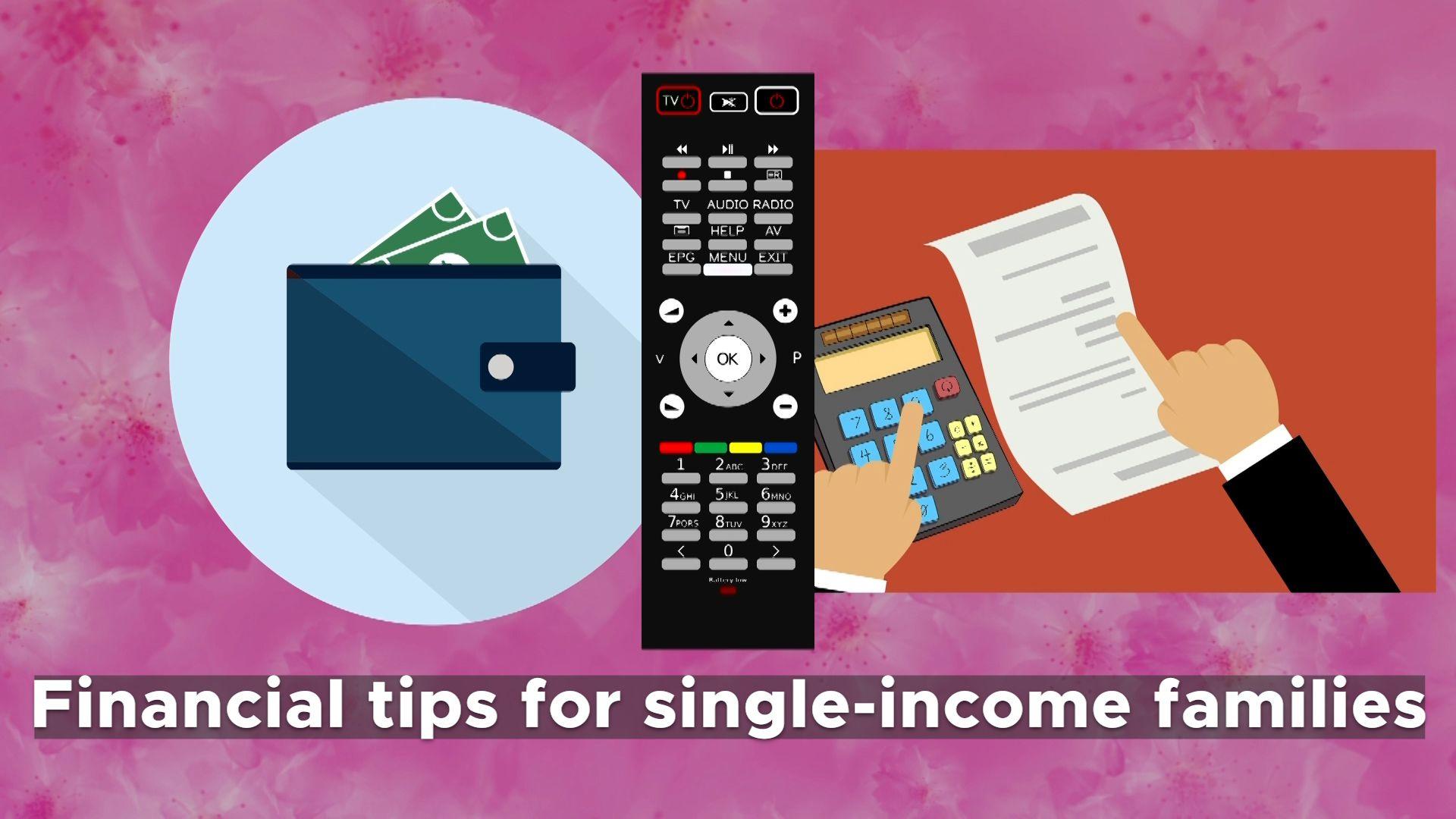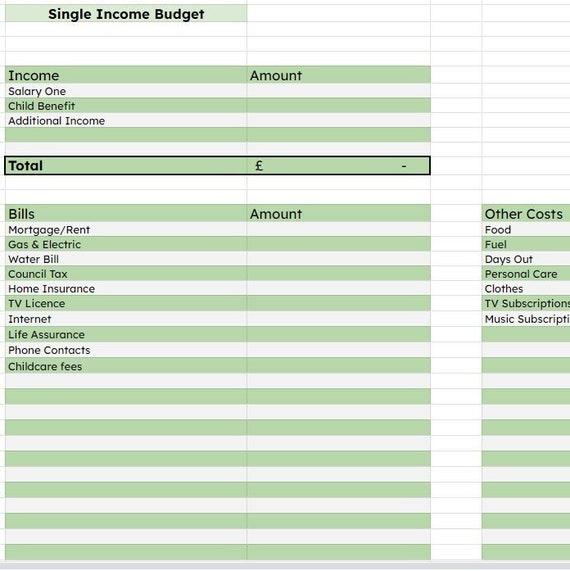In a world where dual incomes often dominate the conversation about household finances, single-income households carve out a unique path-one that calls for thoughtful planning, strategic budgeting, and a keen understanding of priorities. Managing finances on a single paycheck may seem daunting, but it also offers an opportunity to simplify, focus, and build resilience. This article explores practical financial strategies tailored specifically for single-income households, illuminating ways to make every dollar count while securing a stable and fulfilling financial future. Whether by choice or circumstance, mastering money management on one income is both an art and a science-and the journey begins here.
Table of Contents
- Understanding the Unique Challenges of Single-Income Households
- Budgeting with Precision to Maximize Every Dollar
- Smart Saving Techniques Tailored for One Income
- Investing Wisely When Funds Are Limited
- Building a Safety Net Through Emergency Funds and Insurance
- Frequently Asked Questions
- Future Outlook
Understanding the Unique Challenges of Single-Income Households
Living on a single income means that every dollar counts, and financial decisions require careful thought and planning. Unlike dual-income households, where expenses can be more easily absorbed or divided, single-income families often face a tighter budget with fewer financial buffers. This reality brings unique pressures, from managing everyday expenses to planning long-term savings and emergencies.
One of the biggest challenges is cash flow management. With only one steady paycheck, unexpected costs-like medical bills or home repairs-can disrupt financial stability. Developing a detailed budget that prioritizes essentials, while allocating funds for savings and discretionary spending, is crucial. Flexibility within this budget can also help cushion against unforeseen expenses without derailing financial goals.
Another hurdle is balancing lifestyle aspirations with practical constraints. Single-income households might find it harder to maintain the same level of discretionary spending, especially on vacations, entertainment, or luxury items. Strategic choices, such as opting for cost-effective alternatives or prioritizing experiences over material goods, can create a fulfilling life while respecting financial limits.
- Emergency fund: Aim for 3-6 months of living expenses saved.
- Debt management: Prioritize paying down high-interest debts first.
- Investment planning: Automate contributions to retirement or growth accounts.
- Income diversification: Explore side gigs or passive income opportunities.
| Challenge | Impact | Strategy |
|---|---|---|
| Unexpected expenses | Financial disruption | Build and maintain an emergency fund |
| Limited savings | Reduced investment growth | Automate monthly savings contributions |
| Budget rigidity | Stress and reduced flexibility | Regularly review and adjust budget |

Budgeting with Precision to Maximize Every Dollar
Mastering financial management in a single-income household demands a laser-focused approach to budgeting. Prioritizing expenses and understanding exactly where every dollar goes transforms financial stress into confidence. Start by categorizing expenses into essentials, savings, and discretionary spending, ensuring that your fixed costs are covered before allocating funds elsewhere.
Creating a detailed monthly budget is more than just listing numbers-it’s about anticipating fluctuations and preparing for unexpected costs. Utilize tools such as budgeting apps or spreadsheets that allow for real-time tracking and adjustments. This agile method helps you stay on top of your finances, avoiding overspending while maximizing savings potential.
Key practices to implement include:
- Setting a realistic spending limit for non-essential items
- Automatically transferring a portion of income to savings
- Reviewing and adjusting your budget monthly
- Negotiating bills and seeking discounts proactively
| Category | Percentage of Income | Example |
|---|---|---|
| Housing | 30% | Rent or mortgage |
| Utilities & Bills | 10% | Electricity, water, internet |
| Savings | 20% | Emergency fund, retirement |
| Groceries | 15% | Food and household supplies |
| Discretionary | 15% | Entertainment, dining out |
| Miscellaneous | 10% | Unexpected expenses |
Smart Saving Techniques Tailored for One Income
Managing finances on a single income demands a blend of discipline and ingenuity. One of the most effective ways to stretch every dollar is to prioritize needs over wants. This means creating a clear budget that distinguishes essentials like housing, utilities, and groceries from discretionary spending. Regularly reviewing and adjusting this budget can reveal areas where small cuts accumulate into significant savings.
Another powerful strategy is to embrace automated saving. Setting up automatic transfers to a savings account right after payday ensures that saving becomes a non-negotiable habit rather than an afterthought. Over time, this method builds a financial cushion without feeling like a sacrifice. Pair this with the use of high-yield savings accounts or certificates of deposit to maximize gains from your saved funds.
Leveraging community resources and smart shopping can also transform your financial outlook. Consider joining local co-ops, bulk-buying clubs, or utilizing cashback and discount apps tailored for everyday purchases. These small yet consistent efforts help maintain lifestyle quality while keeping spending in check.
| Technique | Benefit | Example |
|---|---|---|
| Budget Tracking | Identifies wasteful spending | Using apps like Mint or YNAB |
| Automatic Transfers | Builds savings effortlessly | Set $200/month to savings account |
| Bulk Buying | Reduces per-unit cost | Buying staples at warehouse stores |
| Utilizing Discounts | Maximizes purchasing power | Coupon stacking and cashback apps |
- Consolidate debts to lower interest rates and monthly payments.
- Plan meals around sales and seasonal produce to save on groceries.
- Limit impulse buys by implementing a 24-hour waiting rule before purchases.

Investing Wisely When Funds Are Limited
When every dollar counts, the path to building wealth requires a thoughtful approach that maximizes every investment opportunity. Start by focusing on low-cost, diversified options like index funds or exchange-traded funds (ETFs). These vehicles offer broad market exposure without the hefty fees, making them ideal for growing your savings steadily over time.
Consistency trumps timing. Even small, regular contributions can compound significantly, so setting up automatic transfers, no matter the amount, is a powerful habit. This disciplined approach helps avoid the pitfalls of trying to predict market highs and lows, which can be especially risky when your financial cushion is thin.
- Prioritize a high-yield savings account for emergency funds
- Explore employer-sponsored retirement plans with matching contributions
- Utilize micro-investing apps to start with minimal capital
| Investment Type | Minimum Investment | Risk Level | Potential Return |
|---|---|---|---|
| Index Funds | $50 | Low | 5-7% annually |
| High-Yield Savings | $0 | Minimal | 1-2% annually |
| Micro-Investing Apps | $5 | Moderate | Varies |
| Employer Retirement Plan | Varies | Low to Moderate | Varies + employer match |

Building a Safety Net Through Emergency Funds and Insurance
In a single-income household, the margin for unexpected expenses is often tighter, making it crucial to establish a robust financial cushion. Creating an emergency fund acts as your first line of defense against life’s uncertainties. Ideally, this fund should cover three to six months’ worth of essential living expenses, providing peace of mind when faced with sudden job loss, medical emergencies, or urgent home repairs.
Start by automating regular contributions to a separate, easily accessible savings account. Even small, consistent deposits can accumulate into a safety net over time. Prioritize this fund over discretionary spending, as its purpose is to protect your household’s financial stability when you need it most.
Beyond savings, insurance plays an equally vital role in shielding your household from major financial shocks. Consider policies that align with your specific risks, such as health insurance, disability coverage, and life insurance. These instruments not only preserve your income but also ensure that unforeseen events don’t derail your long-term financial goals.
- Health Insurance: Covers medical expenses that could otherwise deplete savings.
- Disability Insurance: Provides income replacement if illness or injury prevents working.
- Life Insurance: Supports dependents financially in the event of your passing.
| Type of Coverage | Benefits | Recommended Coverage Amount |
|---|---|---|
| Health Insurance | Medical bills, prescriptions | Full family coverage |
| Disability Insurance | Income protection | 60-70% of monthly income |
| Life Insurance | Financial support for dependents | 10-15x annual income |
Frequently Asked Questions
Q&A: Financial Strategies for Single-Income Households
Q1: What are the biggest financial challenges single-income households face?
A1: Single-income households often grapple with limited cash flow, which can make budgeting tight and saving more difficult. The lack of a second income means less financial flexibility and a greater impact if unexpected expenses arise or if the primary earner faces job loss or reduced hours.
Q2: How can single-income families create a realistic budget?
A2: Start by tracking all income and expenses meticulously for a month or two. Prioritize essential costs like housing, utilities, groceries, and transportation. Then allocate funds for savings and discretionary spending. Using zero-based budgeting or the 50/30/20 rule can help maintain balance and ensure every dollar has a purpose.
Q3: What role does emergency savings play, and how much should be set aside?
A3: Emergency savings are critical for single-income households since there’s no backup income. Ideally, an emergency fund should cover 3 to 6 months’ worth of living expenses. This cushion offers peace of mind and financial stability in case of job loss, medical emergencies, or major repairs.
Q4: Are there effective ways to increase income without adding a second full-time job?
A4: Absolutely. Consider side gigs, freelance work, or monetizing hobbies that offer flexible hours. Additionally, investing in skills that can lead to promotions or higher-paying roles within the current job can boost income without drastically increasing time commitments.
Q5: How can single-income households manage debt efficiently?
A5: Prioritize high-interest debts first, such as credit cards, to reduce financial strain. Consolidating debt or negotiating lower interest rates can also help. Creating a debt repayment plan, like the avalanche or snowball method, provides structure and motivation to become debt-free faster.
Q6: What financial tools or resources are most helpful for single-income families?
A6: Budgeting apps, automatic bill payments, and financial planning software can streamline money management. Seeking advice from financial advisors or attending workshops tailored for single-income households can also provide personalized strategies and support.
Q7: How important is insurance, and what types should single-income households prioritize?
A7: Insurance is vital protection. Prioritize health insurance, disability insurance, and life insurance to safeguard against unforeseen events that could jeopardize financial security. Homeowner’s or renter’s insurance is also essential to protect assets.
Q8: Can single-income households still plan for long-term goals like retirement or education?
A8: Yes, with careful planning. Automate contributions to retirement accounts and look for tax-advantaged savings plans. Even small, consistent investments can grow over time. Prioritizing long-term goals alongside daily expenses ensures financial health well into the future.
Q9: What mindset shifts can support financial success in single-income households?
A9: Embracing flexibility, patience, and creativity helps. Recognizing limitations while focusing on what’s controllable-like spending habits and skill development-empowers families to make steady progress. Viewing budgeting as a tool for freedom rather than restriction can transform the experience.
Q10: Where can single-income households find community or support?
A10: Online forums, local support groups, and financial literacy workshops often cater to single-income or single-parent households. Sharing experiences and strategies creates a sense of community and offers fresh ideas for managing finances effectively.
Future Outlook
Navigating the financial landscape on a single income may seem daunting, but with thoughtful strategies and mindful planning, it becomes not just manageable, but empowering. By embracing a clear budget, prioritizing savings, and seeking smart investment opportunities, single-income households can build a resilient foundation for their future. Ultimately, financial stability is less about the number of income streams and more about the intentional choices made along the way-turning limited resources into lasting security.

